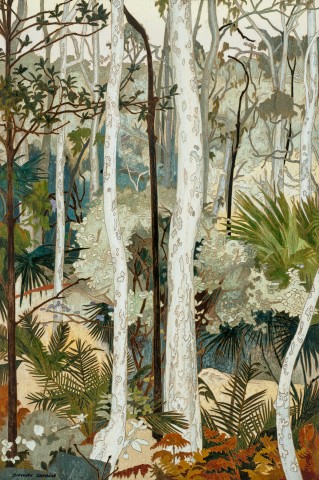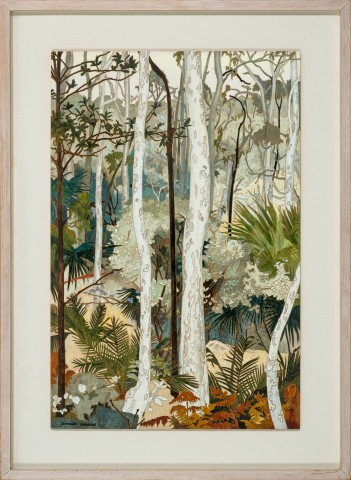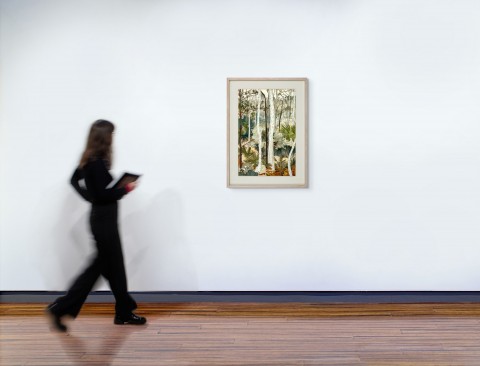SPOTTED GUMS, 1999
CRESSIDA CAMPBELL
watercolour on incised woodblock
75.0 x 49.5 cm
signed lower left: Cressida Campbell
signed verso: Cressida Campbell
Rex Irwin Art Dealer, Sydney (label attached verso)
Acquired from the above by the present owner in 1999
Cressida Campbell, Rex Irwin Art Dealer, Sydney, 13 July – 7 August 1999, cat. 20
Crayford, P., (ed.), The Woodblock Painting of Cressida Campbell, Public Pictures Pty Ltd, Sydney, 2010 (3rd ed.), cat. W9904, 134-135 (illus. detail), 137 (illus.), 352
Cressida Campbell’s incised and hand-painted woodblock, Spotted Gums, 1999 is softly and naturalistically immersive. It presents a familiar and awe-inspiring glimpse into one of Australia’s unique primeval landscapes and preserves its fragile integrity in chalky watercolour paint. Through a rhythmic alternation of dark and light mottled tree trunks Campbell endows this harmonious composition with a dynamic depth of field and an uplifting verticality. The late Nick Waterlow, esteemed Australian curator and art historian, wrote in an introduction to Cressida Campbell’s first solo exhibition in London in 2001 that her distinctive artworks had the capacity to ‘provide constant reminders of the unique wonders of nature in this ancient continent’ and constituted ‘a wonderfully refreshing antidote to all those forces that want to separate us from our surrounding environment.’1
Having lived all her life in pockets of Sydney between bush and the constructed urban environment, and with a predilection for utilising her immediate environs within each artwork, scrubby and chromatically muted scenes of the east-coast bush have been recurrent and steadfast subjects throughout Campbell’s career. Using Spotted Gums as her key image, Campbell chose to group a large number of these works together in her 2008 monograph under the unassuming title ‘Bush’, reuniting vast panoramas with intimate single flower studies, linked through their delicate and detailed evocation of native flora.2
Continuing an enduring tradition of picturing an untouched natural wilderness in Western art, Spotted Gums belongs to a suite of botanical works drawn from life in the endangered, sub-tropical bush around the Stella James House in Avalon, on Guringai country on Sydney’s Northern Beaches.3 The artist and her first husband, Peter Crayford, lived in this heritage-listed Walter Burley Griffin house over the summer of 1999 – 2000. Enclosed by tall stands of Pittwater Spotted Gums and angophora, the house overlooks thirty thousand square metres of open forest on the slopes below. This pristine vegetation was an enticing pictorial subject for Campbell, appearing in several woodblocks and prints between 1999 – 2000, often featuring a combination of Pittwater’s distinctive eucalypts, cycads, and Cabbage Palms.
Framed in the lower corners by pinnated leaves of cycads and browning ferns, the airy composition of Spotted Gums is dominated by the strong vertical lines of the trunks of these gum trees, which tower way beyond the limits of our vision. In the foreground, a wide and mottled eucalypt trunk bisects the composition cleanly from top to bottom. It draws the viewer into Campbell’s view and directs the eye delicately throughout its dense bush, amongst the trunks, deep indigo shadows, and beyond, into the rising sea mist and pale open sky above the horizon line.
While tall, Campbell’s view of this eucalypt forest is contained, a small fragment of the vast view that the artist had enjoyed from where she stood. The artist’s unusual and painstaking practice of painting her woodblocks with watercolour, using a technique similar to cloisonné, lends a chalky, mottled texture to both finished artworks (block and unique print). The inconsistencies and velvety textures left on the block’s surface after the printing process, provide a tactile evocation of the mottled bark and rough surfaces of its subject matter. The clean incised outlines of tree trunks and detailed clumps of leaves dissolve into the damp and shady depths of the forest, keeping a sense of mystery within its detailed naturalism. Campbell’s prints and blocks display a fragment of her reality, leaving clues to hint at what lies beyond the frame. With reverence, Campbell translates the ancient grandeur of Australia’s native flora, and in evoking its unique beauty, silently entreats the viewer for its continuing respect and preservation.
1. Waterlow, N., Cressida Campbell Recent Paintings, Nevill Keating Pictures, London, 2001
2. Crayford, P. (ed.), The Woodblock Painting of Cressida Campbell, Public Pictures, Sydney, 2008, pp. 132 – 191
3. NSW Landcare: https://landcare.nsw.gov.au/groups/stella-james-house-bushcare/
LUCIE REEVES-SMITH


